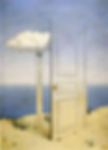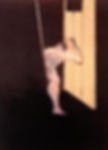Artists and the Image of the Door
- Rossella BLUE Mocerino
- Sep 20, 2023
- 4 min read
We all pass through doors multiple times within a day. We open them, we close them, we lock them and unlock them; we knock and ring on them to get in, we let ourselves in, we smile when a door is opened for us; we close them so we can have privacy. The symbolism of doorways is self-evident. They provide us with security when we close the door on the outside world or they can be the first step toward facing daily challenges as we step out. Locked doors could also have sinister meaning of entrapment and imprisonment. We talk of closed doors when we face insurmountable obstacles. We think of stepping through the dooorway as the first step toward new vistas.
What happens when an artist uses the image of the door in their work? That’s when things get complicated and the door is not anymore a door. As expected, surrealist painters, like Magritte and Delvaux, distance the door from its prescribed purpose. Their works leave us with many unanswered questions, embody mystery and a feeling of disquietude. This feeling of unease is also present in Giorgio de Chirico’s work. Known for his metaphysical paintings, de Chirico assembles strange objects and statues in equally unreal settings. It is not hard to see how his work came to influence surrealist painters like Magritte. Francis Bacon also used the detached door very often in his paintings. Perhaps in his works, the door provides the only stability or support in an otherwise very tortured, writhing and dark existence.

René Magritte places a free standing door at the edge of a sandy bank right next to a body of water in La Victoire (Victory). A cloud is pushing its way through a semi-opened door. You can walk around the door but where can you go? What I find very interesting is the top half of the door is the same colors of the surrounding sky and the lower part of the door takes on the colors of its surrounding. The title is in itself ambiguous. Is it mocking the concept of what humans conceive of as victory? Is this where we are heading? In a barren landscape with no route of escape? Or the other way around, nature will win?

In L’Embellie (The Improvement), Magritte again places an isolated door near a body of water. This time the door is fully opened. The distinction between what is outside and inside is blurred. The clouds are brighter outside and the inside section of the clouded sky is darker, presenting the illusory image of an interior decorated with wallpaper which matches to perfection the landscape. Can we really improve on nature? Notice the spherical object, a recurrent motif in Magritte’s work, on the lower left side of the painting.

In La Résponse Imprėvue (The Unexpected Answer), the door has a gaping hole of undistinguishable shape which alarms us. There seems to be total darkness in the room behind the door. I can’t help to speculate that the artist Renė Magritte had his mother’s suicide in mind when doing this painting. His mother Regina suffered from severe depression and was often kept locked in a room following many unsuccessful suicide attempts.

In Paul Delvaux’s At the Door two formally dressed female figures, who give the impression of being very similar, even though one is a brunette and the other is blonde, are walking in different directions. They do not seem to be aware of each other. They are so engrossed in themselves that one wonders if they are sleep walking. They are both passing through an open door. If the brunette continues on her path, she will come to another open door which is situated right next to a body of water. There is no clear demarcation between the interior world and the exterior world. The movement of the tree and the plant probably indicates a strong wind but not one hair is out of place in the figures. The atmosphere created in this painting is not peaceful but one of anxiety and unease.

Il Ritornante (Returning) by Giorgio de Chirico places two figures in a low ceiling room with a door open enough to indicate a way out of this sinister environment but we do not really know what is on the other side of the door. On this side of the door, there is a marble column, with its eerie shadow, whose top half represents the image of de Chirico’s dead father. The second figure, which seats and kneels at the same time, looks like a tailor’s dummy but this one is mutilated and decapitated. It leans against a box of geometrical tools. I saw this painting at Centre Pompidou in Paris. It is part of their permanent collection.

Francis Bacon’s painting Figure in Open Door is emotionally charged. A naked man is holding on to the handle of a self-standing door and is gazing in another direction which to us looks as dark as the rest of the painting. It seems like the door is also the only source of light. Is that a lamp with a light switch situated on the top left corner of the door? Is there going to be total darkness once again when the door is closed?
I am about to embark in a series of paintings featuring a door. I wanted to see how other artists have dealt with this subject before I started with my own interpretation. I know one thing for sure. My doors are going to be firmly closed.
